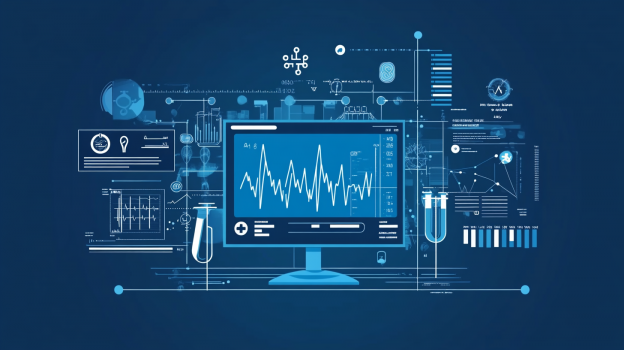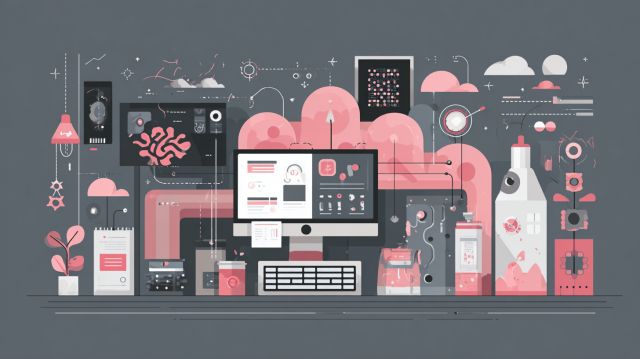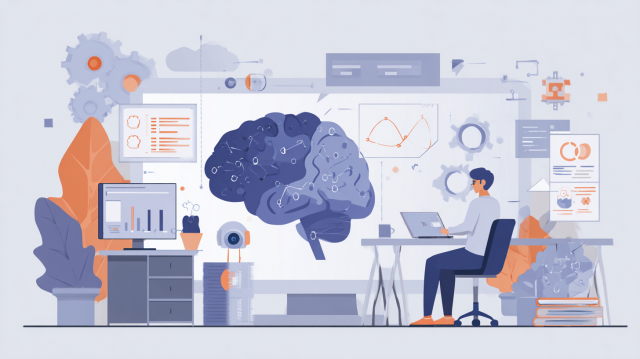
In recent years, the rapid advancement of digital technology has brought about transformation in various fields, and the healthcare industry is no exception. As challenges such as the aging society, rising medical costs, and a shortage of healthcare professionals become more serious, medical DX (digital transformation) is gaining attention as a means to address these issues. In particular, the use of AI holds the potential to significantly enhance the quality of healthcare through improved diagnostic accuracy and operational efficiency, making it an important theme in modern medicine.
This article provides a detailed explanation of the overview of medical DX, the role of AI, specific use cases, as well as its benefits and challenges.
- Table of Contents
1. What is Medical DX?
Definition and Necessity of Medical DX
Medical DX refers to initiatives that utilize digital technology to improve the quality of healthcare and enhance operational efficiency. Currently, many countries, including Japan, are facing challenges such as an aging population, rising medical costs, and a shortage of healthcare professionals, making the promotion of DX essential to address these issues.
The introduction of digital technology is expected to improve the efficiency of medical services and enhance patient convenience in addressing challenges that were difficult to tackle with traditional analog medical systems. In particular, the use of AI technology plays a crucial role in increasing the accuracy of diagnoses and reducing the burden on healthcare professionals.
Definition and Necessity of Medical DX
AI plays a central role in medical DX. Especially with the recent advancements in machine learning technology, it is now possible to provide flexible and highly accurate support in the complex field of image diagnosis, which was difficult with traditional rule-based systems, by continuously analyzing and learning from large amounts of medical data through data-driven AI. This complements physicians' judgments and enables more accurate diagnosis and treatment recommendations.
Reference Blog: What is Medical AI? - Its History and Evolution
For example, AI can detect abnormalities from X-ray and MRI images, and suggest diagnostic candidates based on patient symptom data. In this way, AI is expected to become increasingly important as a support for decision-making in the medical field, leveraging data processing capabilities that exceed human abilities.
2. Use Cases of Medical DX Driven by AI
Advancement of Diagnosis and Image Analysis through AI
AI is making significant advancements in the analysis of CT, MRI, and X-ray images. For example, it detects signs of lung cancer and strokes with high precision, identifying abnormalities that doctors might overlook at an early stage. This is expected to improve diagnostic accuracy and enhance patient prognosis. Additionally, it is being applied to the automation of pathological diagnosis, where AI quickly identifies cancer cells from microscopic images, reducing diagnostic time and alleviating the burden on specialists.
Reference Blog: 3 Examples of Image Diagnosis Using Medical AI
AI-based medical support and automation of electronic medical records
The AI consultation and diagnostic support system analyzes patient symptoms and presents diagnostic candidates to doctors, improving the quality of medical care. This enables fair diagnoses that do not rely on the doctor's experience and also helps reduce the burden on healthcare professionals.
Furthermore, automatic input and summarization technology for electronic medical records is also gaining attention. By utilizing LLM, automatic summarization of medical records becomes possible, reducing the time doctors spend on administrative tasks. As a result, doctors can dedicate more time to patient care.
Online Medical Consultation and Telemedicine Utilizing AI
The use of AI chatbots for initial consultations and triage is a technology that analyzes patient symptoms and automates appropriate medical guidance before the visit. This enables the proper categorization of mild and severe patients, optimizing medical resources.
In addition, the remote medical AI assistant enhances convenience and efficiency by analyzing images of patients' affected areas in real-time and recording conversations using voice recognition technology. This enables the provision of medical care beyond geographical constraints.
3. Benefits of Medical DX
The benefits of medical DX extend to both healthcare professionals and patients.
Benefits for Healthcare Professionals:
By assisting doctors with diagnoses, AI improves diagnostic accuracy and reduces the risk of oversight. Additionally, by automating administrative tasks and patient interviews, AI alleviates the workload, allowing healthcare professionals to focus more on patient care. Furthermore, the introduction of triage systems enables appropriate guidance for consultations based on symptoms, enhancing the efficiency of medical settings.
Benefits for Patients:
With the advancement of telemedicine and online consultations, patients can receive examinations from specialists while at home, eliminating geographical constraints. Improved accuracy of AI-assisted diagnosis allows patients to receive more accurate diagnoses and treatments.
4. Challenges in Medical DX and Barriers to AI Implementation
One of the biggest challenges in implementing AI is the issue of initial costs. Developing and introducing AI systems requires a significant investment, which poses a major hurdle, especially for small and medium-sized medical institutions.
In addition, the privacy and security of medical data are also important issues. Medical AI systems that handle patient information require strict measures to prevent personal information leaks.
Furthermore, the reliability and explainability of AI are also challenges. For doctors to trust and utilize AI's judgments, the decision-making process needs to be transparent and understandable. However, many aspects of current AI technology are seen as black boxes, indicating that improvements are necessary.
5. The Future and Prospects of AI in Medical DX
In the future, with the evolution of generative AI, further applications in the medical field are expected, such as clinical support, medical record creation, and summarizing medical papers. This is anticipated to reduce the burden on healthcare professionals and improve operational efficiency.
In addition, the development of 5G and IoT is expected to further expand telemedicine. The realization of real-time diagnostics and remote surgeries utilizing high-speed communication technology has the potential to dramatically improve opportunities for healthcare delivery and the quality of medical care.
Furthermore, with the advancement of collaboration between AI and wearable devices, significant evolution in preventive healthcare is also anticipated. By analyzing real-time data such as heart rate and sleep patterns, AI can detect early signs of diseases, enabling interventions before onset, and it is expected to contribute to maintaining patients' health.
6. Summary
AI in medical DX has become a significant presence that can bring great advantages to the medical field through improved diagnostic accuracy and operational efficiency. Examples of its use, such as image analysis and telemedicine, are leading to a reduction in the burden on doctors and the provision of high-quality medical care, while also enhancing patient convenience and equity in medical access. However, challenges remain in the introduction of AI, including costs, privacy, and reliability, necessitating technological innovation and policy development. In the future, advancements in generative AI and 5G are expected to accelerate medical DX, leading to the evolution of personalized and preventive medicine, and fostering the realization of a healthy society.
7. Human Science Medical Annotation Services
●Extensive annotation experience in medical imaging
Our company has extensive experience in medical image annotation that requires skill transfer, such as surgical images and MRI images, which are of high difficulty and specialization. In addition to experienced project managers in medical image annotation projects, we also have many skilled workers, ensuring high-quality annotation even for projects that are complex, specialized, and require skill transfer.
●Support for physician supervision and annotations by physicians
It can be concerning to have only general workers perform all tasks. In such cases, we receive requests for supervision by a physician for certain check tasks. To meet these requests, we have further strengthened our physician supervision system, allowing us to handle more complex annotations. Additionally, even if you request annotations by physicians instead of general workers, our project managers will provide comprehensive management services, ensuring resource allocation, quality, and progress management.
●Resource management without using crowdsourcing
At Human Science, we do not use crowdsourcing. Instead, projects are handled by personnel who are contracted with us directly. Based on a solid understanding of each member's practical experience and their evaluations from previous projects, we form teams that can deliver maximum performance.
●Equipped with a security room in-house
Within our Shinjuku office at Human Science, we have secure rooms that meet ISMS standards. Therefore, we can guarantee security, even for projects that include highly confidential data. We consider the preservation of confidentiality to be extremely important for all projects. When working remotely as well, our information security management system has received high praise from clients, because not only do we implement hardware measures, we continuously provide security training to our personnel.
Supports not only annotation but also the creation and structuring of generative AI LLM datasets.
In addition to labeling for data organization and annotation for identification-based AI systems, Human Science also supports the structuring of document data for generative AI and LLM RAG construction. Since our founding, our primary business has been in manual production, and we can leverage our deep knowledge of various document structures to provide you with optimal solutions.

 Text Annotation
Text Annotation Audio Annotation
Audio Annotation Image & Video Annotation
Image & Video Annotation Generative AI, LLM, RAG Data Structuring
Generative AI, LLM, RAG Data Structuring
 AI Model Development
AI Model Development In-House Support
In-House Support For the medical industry
For the medical industry For the automotive industry
For the automotive industry For the IT industry
For the IT industry




























































































